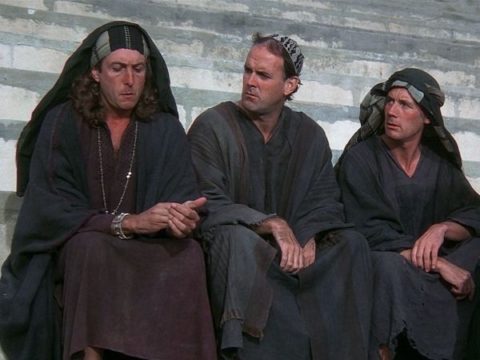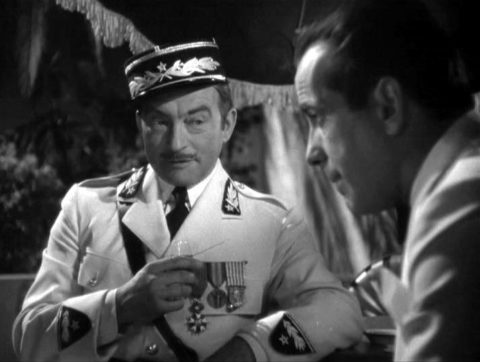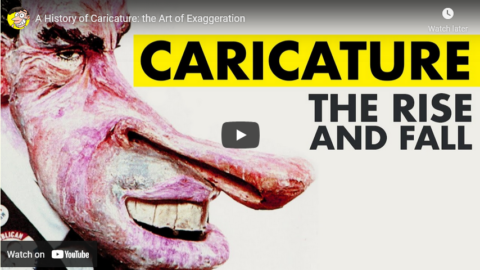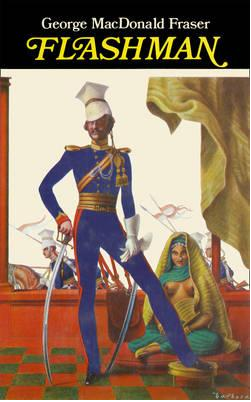Folding Ideas
Published 10 Feb 2017Clickbait title: Nazis hate him! Secrets of propaganda exposed!
This took far longer to put together than I’d anticipated. It wasn’t even the work itself, it’s the emotional load. I eventually had to start chopping out huge planned segments, like looking at modern propaganda like that awful “Surfing in the DPRK” white guy rap video. I’m sorry about the downer ending, but there’s no way to spruce it up. To a certain degree we lost.
You should seriously read, and then re-read, Umberto Eco’s “Ur-Fascism”. It’s available online for free. It’s not that long. Here, I’ll even link it for you. http://www.nybooks.com/articles/1995/…
Books mentioned:
Urania’s Children
The Occult Roots of Nazism
The Origins of TotalitarianismWritten and performed by Dan Olson
Twitter: https://twitter.com/FoldableHuman
February 22, 2022
Triumph of the Will and the Cinematic Language of Propaganda
January 25, 2022
QotD: James Bond’s stand-in
Like many a kiddy growing up in the 1960s, the release of a new James Bond film was a thrilling event. My cohort were too young to know about sex proper but the saucy suggestiveness of the Sean Connery films was the nearest we got to it. Once, a rumour went around our school that there was a kissing stand-in man employed on Bond films in order to get the lighting right rather than keep bothering the star with snogging various starlets; the careers officer became quite exasperated with the 16-year-old school-leavers he dealt with that year.
Julie Burchill, “How James Bond became the prisoner of woke”, Spiked, 2021-10-14.
January 14, 2022
Why Real Explosions Don’t Look Like Movie Explosions
Tom Scott
Published 8 Mar 2021Explosions on film are made to look good: fireballs and flame. In reality, though, they’re a bit disappointing. Here’s how Hollywood does it.
• Produced with an experienced, professional pyrotechnician. Do not attempt.
Thanks to Steve from Live Action FX: http://liveactionfx.com/
Filmed safely: https://www.tomscott.com/safe/
Camera: Simon Temple http://templefreelance.co.uk
Edited by Michelle Martin: https://twitter.com/mrsmmartinI’m at https://tomscott.com
on Twitter at https://twitter.com/tomscott
and on Instagram as tomscottgo
December 29, 2021
QotD: The pervasive infantilization of the “elites”
One is tempted to go first after the fattest target, Harry Potter (one is even more tempted to make the obvious jokes about “academia” and “fattest”, but one will manfully resist). The thing is, I think I get the appeal of something like Game of Thrones — the part of the appeal that isn’t spelled “scads and acres and furlongs and metric shitloads of tits,” that is, which makes up the appeal of 99% of any given HBO show (seriously, where would that network be without gratuitous nudity?).
We’ll get there, fear not. But the appeal of Harry Potter absolutely eludes me. I’m sure it’s a charming enough story, but … it’s kid stuff, and they’re not reading it with their kids, because they don’t have kids. And it’s really creepy, y’all, how seriously they take this kids’ stuff. As Vizzini pointed out yesterday, the very mature deep thinkers in the Totally Legit Joe regime are whiling away their hours behind the razor wire by choosing spirit animals for themselves, based on their favorite Harry Potter characters. And while that is absolutely the kind of thing those imbeciles should be doing, instead of attempting to govern, not a one of them is under age 40 (Jen Psaki, for instance, is 43 — and also, according to anonymous White House sources, a “wild cat”; make of that information what you will).
Part of it is just the infantilization of American culture, of course, but it’s strange and disturbing how the more educated, professional classes seem to be not just more infantile than the hoi polloi, but much more passionate about it, too. I know a senior ER doc at a big hospital, for instance, who is waaaaay into Star Wars. And I don’t mean Star Wars collectibles, though of course he has a bunch of those, and as silly as that is in itself (guilty as charged; let me show you my baseball cards sometime).
I mean the dude is just really, really, really into Star Wars. He’s got Star Wars shit all over his house … his huge, grossly expensive, “befitting a senior trauma surgeon whose wife is also a big league university administrator” house, in the toniest part of town, to which he routinely invites other big league people, including — for professional purposes — politicians and powerful apparatchiks. And let me hasten to add, he’s not House MD, whose abrasive “quirks” are tolerated because of his preternatural genius. This guy is, himself, a slick political operator; he’s got plenty of social savvy. But … he’s also got a scale model Millennium Falcon hanging from the roof in the dining room.
I’m sure there’s an explanation for how nobody but me seems to find this really, deeply, disturbingly fucking odd … but there it is.
Severian, “The One Pop Culture Thing”, Rotten Chestnuts, 2021-09-16.
December 2, 2021
“Good idea, Judith. We shall fight the oppressors for your right to have babies, brother. Sister. Sorry.”
The power of Python compelled Stephen Green to write this:

Stan: “I want to be a woman. From now on, I want you all to call me ‘Loretta’.”
Still from Monty Python’s Life of Brian, 1979.
Of all the jokes, gags, and barbs thrown in every direction, Jesus is the only figure shown respect. Monty Python trouper Eric Idle later said of Jesus, “What he’s saying isn’t mockable, it’s very decent stuff.”
For a non-believing, take-no-prisoners comedian like Idle, that’s practically a whole-hearted endorsement.
Instead, the film — Python’s only real film, the others were basically collections of sketches, even Holy Grail — is anti-authoritarian, anti-fanaticism, anti-nihilism, and anti-humorless prigs.
Life of Brian is, however, very pro-funny.
The Pythons even saved their sharpest barbs for political extremists and self-deluded lefties.
Case in point on that last observation: The classic Colosseum conversation between the would-be revolutionaries of the Judean People’s Front.
Or was that the People’s Front of Judea?
Regardless, take two minutes (clip below!) to bask in the comedic good sense that would get the cast and entire production crew canceled in our times.
The postmodern Left should probably cancel everyone who laughed at this scene, just to be safe.
Anyway, point-by-point, Monty Python satirically dissected the then-nascent cultural trends that have since come to dominate not only our culture, but also our politics and even our private lives.
Enjoy … although I will admit that re-watching this today, the laughs were a bit more bitter than they were when I first watched Life of Brian nearly 40 years ago.
November 30, 2021
QotD: Getting to dystopia
I’d like to pick up on that first thought of mine: When I was a kid and watched sci-fi movies set in a futuristic dystopia where dehumanized individuals are mere chattels of an unseen all-powerful machine policed by commissars in identikit variety-show tinfoil suits in a land where technology has advanced but liberty has retreated, I always found the caper less interesting than the unseen backstory: How did they get there from here? And […] we’re now in the getting-there-from-here phase.
Things are changing very fast. And, if we don’t fully understand why they’re changing and where they’re heading, we’re going to end up in one of those dehumanized dystopias — and very soon.
Mark Steyn, “Live Around the Planet: Tuesday January 22nd”, Steyn Online, 2019-01-22.
November 17, 2021
QotD: From Theda Bara to Lady Gaga
… despite showing acres of pallid flesh in the fetish-bondage garb of urban prostitution, Lady Gaga is far less sexy than Stefani Germanotta used to be. In fact, Gaga isn’t sexy at all — she’s like a gangly marionette or plasticised android. How could a figure so calculated and artificial, so clinical and strangely antiseptic, so stripped of genuine eroticism have become the icon of her generation? Can it be that Gaga represents the exhausted end of the sexual revolution? In Gaga’s manic miming of persona after persona, over-conceptualised and claustrophobic, we may have reached the limit of an era.
In 1933, the critic I.A. Richards, writing about “The Waste Land”, spoke of T.S. Eliot’s “persistent concern with sex, the problem of our generation, as religion was a problem of the last.” After the first world war, sexual experimentation and titillating smart talk became the hallmark of the emancipated new woman, who smoked, drank, bobbed her hair and danced the antic Charleston. Hollywood discovered that sex was great box office — leading to pressure from civic and religious groups for a production code, which movie-makers found ingenious ways to evade.
We are approaching the 100-year anniversary of Hollywood sex: Theda Bara’s incarnation as The Vamp in A Fool There Was (1915), a lurid femme fatale who slew overnight the lingering Victorian ideal of the pure, saintly woman-child, portrayed on screen by Mary Pickford and Dorothy and Lilian Gish. Theda Bara, like Lady Gaga, was a manufactured personality; although the studio publicity department claimed she was born in the Sahara to a French artist and Arabian princess, she was actually Theodosia Goodman, the daughter of a Jewish tailor in Cincinnati.
The sexual icon of 1920s Hollywood was Clara Bow, a madcap flapper who was probably falsely rumoured to have bedded the entire University of Southern California football team. Lithe Louise Brooks, with her signature bobbed hair, made landmark films of decadent eroticism in Germany. Wicked Mae West and lushly buxom Jean Harlow began the tradition of the sex bomb, which continued through Hedy Lamarr to Jane Russell and Marilyn Monroe, whose influence endures around the globe. But the cardinal sexual pioneer was Marlene Dietrich, who exploded on the international scene in 1930 as the heartless cabaret singer of The Blue Angel. In her subsequent films with the director Josef von Sternberg, Marlene toyed with transvestism (based on the drag balls of Weimar Berlin) and created the sophisticated look of hard glamour that remains a staple of fashion magazines.
Marlene was Madonna Louise Ciccione’s idol; the seductive, commanding Marlene permeates Madonna’s brilliant videos of the 1980s and the early ’90s, with their dominatrix, transvestite and bisexual motifs. Madonna wanted to play Marlene on film, but the idea was overruled by Marlene herself, who (as the proud daughter of a Prussian officer) decreed Madonna “too vulgar”.
Weimar cabaret was recreated in the 1972 film Cabaret, based on Christopher Isherwood’s Berlin stories. Bob Fosse’s dazzlingly aggressive choreography in that blockbuster film was adopted by Madonna for her videos and stage shows — all of which have been doggedly imitated by Lady Gaga. Gaga has borrowed so heavily from Madonna (as in her latest “Alejandro” video) that it must be asked, at what point does homage become theft? But the main point is that the young Madonna was on fire. She was indeed the imperious Marlene Dietrich’s true heir. Madonna’s incandescence is still on view in videos like “Open Your Heart”, “Vogue” and “Express Yourself”. However, for Gaga, sex is mainly decor and surface; she’s like a laminated piece of ersatz rococo furniture. Alarmingly, Generation Gaga can’t tell the difference. Is it the death of sex? Perhaps the symbolic status that sex had for a century has gone kaput; that blazing trajectory is over.
Camille Paglia, “Lady Gaga: The Death of Sex”, Sunday Times, 2010-09-12.
November 9, 2021
QotD: Hollywood in the late Golden Age
In certain ways, Hollywood today is just like it was a half-century ago. It’s a company town, a plantation devoted to the manufacture of cultural commodities designed to please the largest possible number of people. Then as now, nearly all of the films produced there fit neatly into the pigeonholes of a limited number of highly stylized genres: gangster movies, costume dramas, romantic comedies, Westerns.
The main difference between then and now is that in the old days, such films were mass-produced on the assembly lines of the major studios. Americans of all ages went to the movies at least once a week, and they expected to see something different every time they went. Hence the studio system, which ground out product fast enough to meet the omnivorous demand. Except for the occasional Gone With the Wind, the modern Spielberg-style “event” movies that now dominate Hollywood filmmaking didn’t exist. You went to the movies not to see Spider-Man or Lord of the Rings, but simply to see a show. If the show in question was a Western or a mystery, that was good; if it starred John Wayne or Robert Mitchum, that was better. But nobody went out of his way to see a Wayne Western directed by Howard Hawks, much less a Mitchum mystery directed by Jacques Tourneur. You took what you got, and if what you got happened to be a Red River or Out of the Past, then you got lucky.
That’s why so many of the best films made in Hollywood in the Forties and Fifties were Westerns and mysteries. Precisely because they were commodities, their makers tended to be ignored by the front office. So long as your last picture turned a profit, however small, you got to make another one. If the movies in which you specialized were low-budget genre pictures for which demand was more or less constant, all that mattered was that you stay more or less within the accepted conventions of the genre, and the conventions of the Western and the mystery happened to be wonderfully well-suited to the artful telling of serious stories that were both entertaining and cheap to produce. The art, of course, was optional, and most such movies were as forgettable as a Law and Order rerun, but some of them were as good — and as serious — as a movie can be.
Terry Teachout, “What Randolph Scott Knew”, American Cowboy, 2005-12-23.
November 3, 2021
Casablanca had a small but significant historical error
And it’s not Captain Renault’s throwaway line about the Americans marching into Berlin (which, of course, did not happen in 1918). The error that Michael Curtis points out is very easy to miss:

Still from Casablanca (1942), with Captain Renault (Claude Rains) asking Rick Blaine (Humphrey Bogart) why he came to Casablanca.
As time goes by, there is a consensus that Casablanca, the story of the cynical hard drinking American expatriate night club owner choosing between his love for a woman or helping her and her husband, a resistance hero escape from the town of Casablanca, a complex town controlled by the Vichy state under Nazi occupation, is one of the greatest films of all time. Its characters, dialogue, theme song, have become iconic. We’ll always have Casablanca. It is a film of moral ambiguity, that can be seen either as a theme of love and sacrifice, or as a political allegory about resistance against Nazism.
However, this brilliant film has a flaw. In one scene the camera focuses on the prefecture of the corrupt chief of police on the wall of which is the motto of the French Third Republic, “liberty, equality, fraternity”, inherited from the 1789 French revolution. But the Third Republic had been ended in May 1940, and its motto had been officially replaced by the slogan, “work, family, homeland”, of the new French State, popularly known as Vichy. The differences between the two mottos are still pertinent in French politics and culture today.
Some political and cultural problems are easy to solve, even if costly. Scotland recently spent seven months of research and $162,000 to create a new slogan that would increase tourism. It finally came up with a banal slogan, “Welcome to Scotland”. There is no easy solution for France which has been and remains a sharply divided society still confronting its history of the World War II years, the defeat of the French army by the Germans in June 1940, the end of the Third Republic and its replacement by the French State headed by 84 year old Marshall Philippe Petain, regarded as a hero of Verdun in World War I, located in Vichy, a spa in the Auvergne.
The Vichy régime participated in persecution and discrimination of the Jewish population, by aryanisation of property, propaganda, antisemitic ideology, anti-Jewish legislation, roundups, deportation to death and concentration camps. In view of this antisemitic attitude, it is a paradox that after the War, 75% of the Jewish population in France remained alive, the result of complex religious, cultural, and international factors. This can be compared to extermination of 80% of Jews in the Netherlands, and 45% in Belgium.
Nevertheless, 75,721 Jews were deported from France, and fewer than 2,000 survived. Persecution was extensive. Jews were banned from professions, civil service, journalism, business, entertainment, refugee Jews were held in concentration camps under French control, antisemitic legislation affected all Jews, and the tragedy of Vel d’Hiv occurred. French police carried out the first mass arrests of Jews in Paris in May 1941, and the first French deportation train left on March 12, 1942. The most infamous event, the roundup by French gendarmes, using batons and hoses, of 13,000 Jews took place on July 16-17, 1942 when the victims were taken to the Vel d’Hiv indoor bi-cycling stadium in Paris before being deported to Nazi camps. They included 7916 women, 1129 men and 4115 children.
By the so-called National Revolution, France would be rescued from the decadent Third Republic, and returned to purer values. The controversy continues. Was France guilty of contributing to the Holocaust, and who was responsible? First, were collaborators and sympathizers with the Nazis only a minority of the population and was Petain the “shield”, protecting France and the French people as much as it could within the country, while General de Gaulle abroad was the “sword”. A second defense was that Vichy could do little while the Germans occupiers were responsible. A third point is that Vichy tried to protect French national Jews by collaborating in the persecution, the deportation and ultimately extermination of foreign Jews in France.
October 29, 2021
Lying About the Jews in Film – WW2 Special
World War Two
Published 28 Oct 2021How do you convince your people to hate and fear their neighbors, to support a genocidal war of aggression, and see you as their only hope? If you are Adolf Hitler or Joseph Goebbels, the answer is simple: you send them to the cinema.
(more…)
September 23, 2021
Nazi Fanatics and Gangland Executions | B2W: ZEITGEIST! I E.26 Winter 1925
TimeGhost History
Publisheed 22 Sep 2021The winter of 1925 is a season of gun battles and assassinations. Al Capone is fighting both the Chicago police and rival gangs to gain control of the bootlegging racket, and a Nazi party fanatic murders a Viennese author for his writings on anti-Semitism and eroticism. It’s not all violence, though. This season, a landmark documentary film is released.
(more…)
July 29, 2021
Buster Keaton, British Imperialism, and the Era of Spectacle | B2W: ZEITGEIST! I E.23 Spring 1924
TimeGhost History
Published 28 Jul 2021There’s no business like show business and in the spring of 1924, you can see why. Buster Keaton and Hollywood as a whole are producing some iconic films, the British Empire is putting on a massive exhibition, and there is even talk of a death ray.
(more…)
July 13, 2021
QotD: Girls and witchcraft
Like many Canadian teenage girls who came of age in the 1990s, I grew up on 2% milk, dime-store candy and tales of the occult. I was slightly too old for the Harry Potter craze, falling instead for Buffy the Vampire Slayer and films such as The Craft. One of my special favorites was Sabrina the Teenage Witch, an ABC series about a magical American teenager who lives with her 500-year-old aunts and a talking cat.
Witchcraft fascinated me. When girls reach that liminal time between child and woman, our bodies transform — and, with them, our sense of control. It’s a strange thing to go from being cosseted and encouraged to desired and despised. It feels a little like dark magic — though not the kind one can control. Unless, of course, you are a witch.
Like the magical artifacts Harry Potter is always stumbling upon, witchcraft offers power. It promises a way to re-shape the world to a girl’s advantage, to gain freedom from parents, to toy with boys’ hearts while numbing one’s own. Male magic fantasies tend to be centred around power and combat — with lightning perpetually emanating from wands and fingertips into the chests of adversaries blown backwards. However, the sort of witchcraft that interests me is more subtle, and sometimes passes unseen. (In real life, such powers originate in sex — but it takes time for a girl to learn that.) It’s no coincidence that the world of witchcraft becomes a dark mirror of our society, reflecting the dispositions and paranoias of our times. When times are good, the witch is portrayed as a benign, bubbly figure; when they are not, the witch becomes malevolent and dark, in line with medieval lore.
Jen Gerson, “Sabrina the Woke Witch is a Disgrace to Baphomet”, Quillette, 2018-11-26.
July 10, 2021
A History of Caricature: the Art of Exaggeration
J.J. McCullough
Published 27 Mar 2021Let’s look at the history of caricature, the art of drawing exaggerated cartoon pictures of famous people like celebrities, politicians, and movie stars. We’ll look at the style of great artists like Al Hirschfeld, Gerald Scarfe, and Robert Risko among others.
Voice cameo by Alec: https://www.youtube.com/user/bostwiki
FOLLOW ME:
🇨🇦Support me on Patreon! https://www.patreon.com/jjmccullough
🤖Join my Discord! https://discord.gg/3X64ww7
🇺🇸Follow me on Instagram! https://www.instagram.com/jjmccullough/
🇨🇦Read my latest Washington Post columns: https://www.washingtonpost.com/people…
🇨🇦Visit my Canada Website http://thecanadaguide.comHASHTAGS: #caricature #art #history
July 9, 2021
Alexander Larman on George MacDonald Fraser’s Flashman novels
I happened upon a copy of the first Flashman in my teens and was totally taken in by the assertion that the book was about “a real historical figure involved in most of the Victorian era’s most notorious episodes and that his papers were discovered during a sale of household furniture at Ashby, Leicestershire in 1965.” I’d watched the TV adaptation of Tom Brown’s Schooldays, so I had some awareness about the character Flashman, which only helped keep the cover story going for me. I absolutely loved the book and while it eventually became clear that it was fiction, I haunted the bookshops for years afterwards searching for more from Fraser. In The Critic, Alexander Larman looks at the author and his works — which almost certainly could never have been published in this neo-Victorian age:
When Flashy first entered the scene in bestselling form in 1969, there was confusion as to whether the tales were fanciful fiction or eyebrow-raising fact. This was due to MacDonald Fraser’s straight-faced claim that his protagonist was a real historical figure involved in most of the Victorian era’s most notorious episodes and that his papers were discovered during a sale of household furniture at Ashby, Leicestershire in 1965.
MacDonald Fraser presented himself as an impartial editor. He wrote, “I have no reason to doubt that it is a completely truthful account; where Flashman touches on historical fact he is almost invariably accurate, and readers can judge whether he is to be believed or not on more personal matters.”
The subterfuge succeeded. A third of the initial reviews treated it as a serious work of non-fiction, rather than a brilliantly conceived and superbly written counter-factual piece.
Not bad for the continued exploits of a minor character in the sanctimonious Victorian novel Tom Brown’s Schooldays, whose major achievement is to bully the protagonist and his friend Harry “Scud” East, before being expelled for drunkenness. It set its creator on a hugely lucrative path, and established him as one of the great comic novelists of his day.
MacDonald Fraser was a contradictory figure. A patriotic right-winger who had a deep respect for other cultures and peoples; one of Hollywood’s most in-demand screenwriters who happily lived on the Isle of Man in a self-conscious recreation of “the good old days”; a fully paid-up reactionary who wished to reintroduce corporal and capital punishment, but who loathed British incursions abroad.
Above all, he despised cant and hypocrisy. He described Tony Blair as “not just the worst prime minister we’ve ever had, but by far the worst prime minister we’ve ever had” and angrily added, “it makes my blood boil to think of the British soldiers who’ve died for that little liar.”
Christopher Hitchens, who may not have agreed with his views on foreign expeditions, but knew a thing or two about the value of being able to hold one’s drink, was a friend of MacDonald Fraser’s. When Hitchens telephoned him on his eightieth birthday to offer his regards, he was stoutly informed that he shared the company of “Charlemagne, Casanova, Hans Christian Andersen and Kenneth Tynan” on that date.
Their politics may have differed — Christopher acknowledged MacDonald Fraser’s “robust Toryism” — but Hitchens respected the older writer’s enduring affection for his Zulu, Sikh and Afghan characters, as well as the dutiful admiration he showed towards both American culture and its presidents.







